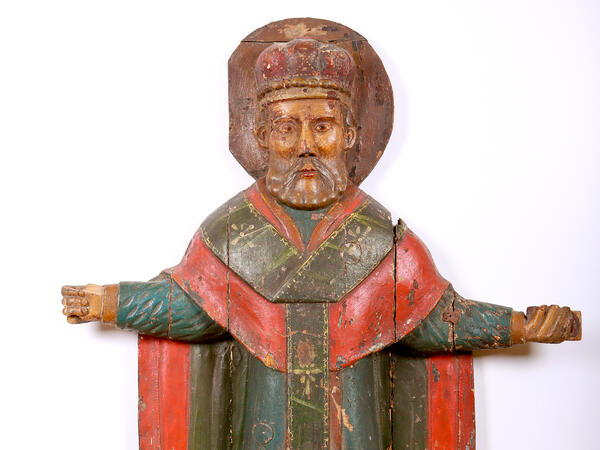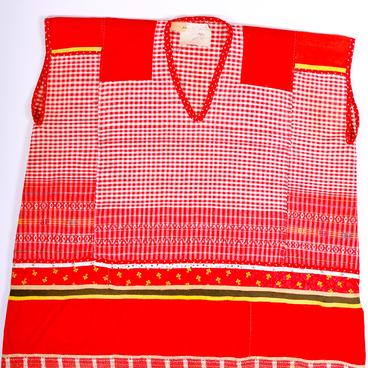In the 17th century, the church fought against sculptures that depicted a person: they considered such sculptures as the influence of Catholicism and pagan beliefs. It was forbidden to make them, and existing statues were destroyed. Despite this, the craftsmen still made wooden figures for churches, and several rare sculptures have survived to our time. They have been preserved mainly in the collections of museums.
The exhibition of the Kasimov Historical and Cultural Museum-Reserve contains a church polychrome sculpture of the 17th century — Saint Nicholas of Mozhaysk or Nikola Mozhaysky, one of the images of Saint Nicholas the Wonderworker.
Nikola Mozhaysky is depicted in full height with his arms raised and outstretched to the sides: in his right hand, he held a sword, and in his left — a ‘city’, an image of a fortress church, which symbolized the city of Mozhaysk. Now, these elements are lost. The Wonderworker is dressed in a festive red vestment; he has a crown on his head.
Saint Nicholas was born at the end of the 3d century in the city of Patara in Asia Minor, on the territory of modern Turkey. He served as archbishop in the neighboring city of Mira. In Rus, the image of Nicholas has become popular since the 16th century. Then, according to the legend, St. Nicholas appeared in the sky and saved Mozhaysk from the Mongol invasion. Legend has it that when enemy troops besieged the city, the inhabitants began to pray to the saint and ask him for help. Suddenly, Saint Nicholas appeared in the sky above the cathedral and had a formidable appearance, with a sword and a church in his hands. The enemies retreated in horror.
Before this incident, St. Nicholas was more often depicted with his right hand in a blessing gesture. In his left hand, he held the Gospel. After the miracle in Mozhaysk, the canon changed: a sword and a ‘city’ were put into the hands of the saint, and Nicholas the Wonderworker himself became the protector of the city.
Before the revolution, Saint Nicholas was revered as a Santa Claus. In the biography of the saint, there was a legend that he helped poor families and left gifts for children on Christmas Eve. In 1929, church holidays were officially banned in the USSR, and a few years later, it was allowed to hold children’s New Year parties. Then the image of Santa Claus, familiar to us, appeared.
The exhibition of the Kasimov Historical and Cultural Museum-Reserve contains a church polychrome sculpture of the 17th century — Saint Nicholas of Mozhaysk or Nikola Mozhaysky, one of the images of Saint Nicholas the Wonderworker.
Nikola Mozhaysky is depicted in full height with his arms raised and outstretched to the sides: in his right hand, he held a sword, and in his left — a ‘city’, an image of a fortress church, which symbolized the city of Mozhaysk. Now, these elements are lost. The Wonderworker is dressed in a festive red vestment; he has a crown on his head.
Saint Nicholas was born at the end of the 3d century in the city of Patara in Asia Minor, on the territory of modern Turkey. He served as archbishop in the neighboring city of Mira. In Rus, the image of Nicholas has become popular since the 16th century. Then, according to the legend, St. Nicholas appeared in the sky and saved Mozhaysk from the Mongol invasion. Legend has it that when enemy troops besieged the city, the inhabitants began to pray to the saint and ask him for help. Suddenly, Saint Nicholas appeared in the sky above the cathedral and had a formidable appearance, with a sword and a church in his hands. The enemies retreated in horror.
Before this incident, St. Nicholas was more often depicted with his right hand in a blessing gesture. In his left hand, he held the Gospel. After the miracle in Mozhaysk, the canon changed: a sword and a ‘city’ were put into the hands of the saint, and Nicholas the Wonderworker himself became the protector of the city.
Before the revolution, Saint Nicholas was revered as a Santa Claus. In the biography of the saint, there was a legend that he helped poor families and left gifts for children on Christmas Eve. In 1929, church holidays were officially banned in the USSR, and a few years later, it was allowed to hold children’s New Year parties. Then the image of Santa Claus, familiar to us, appeared.


